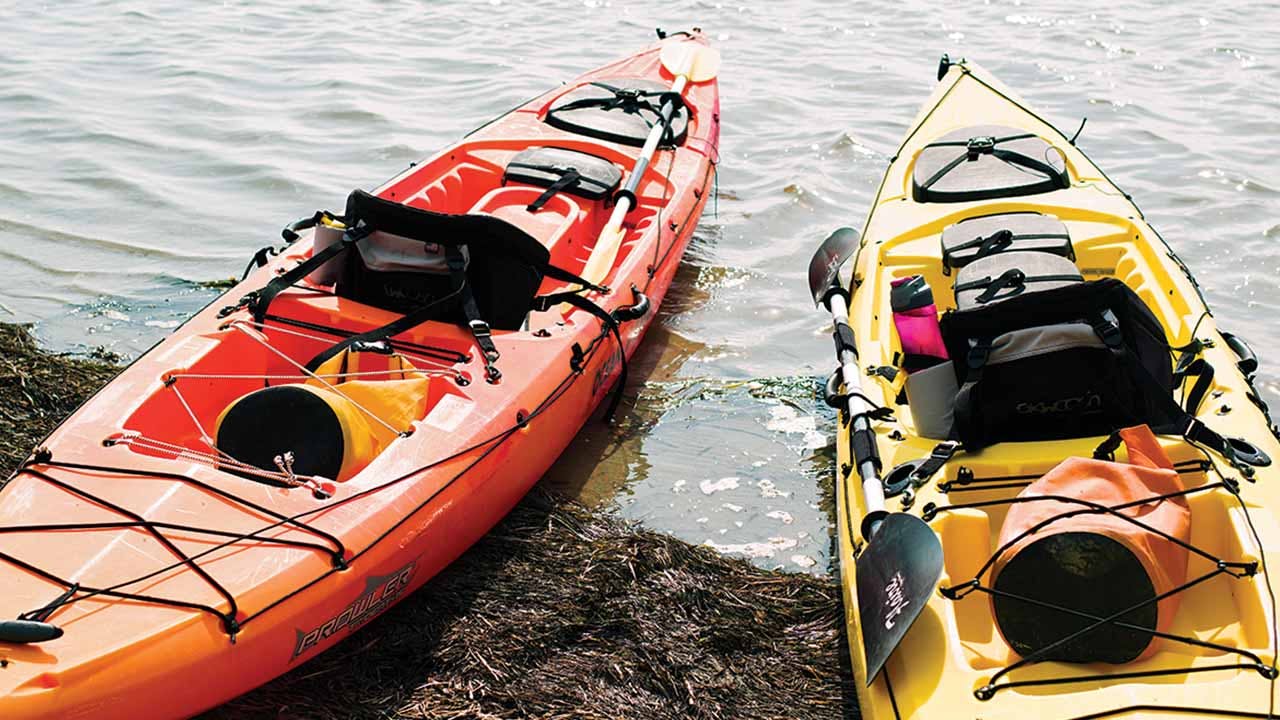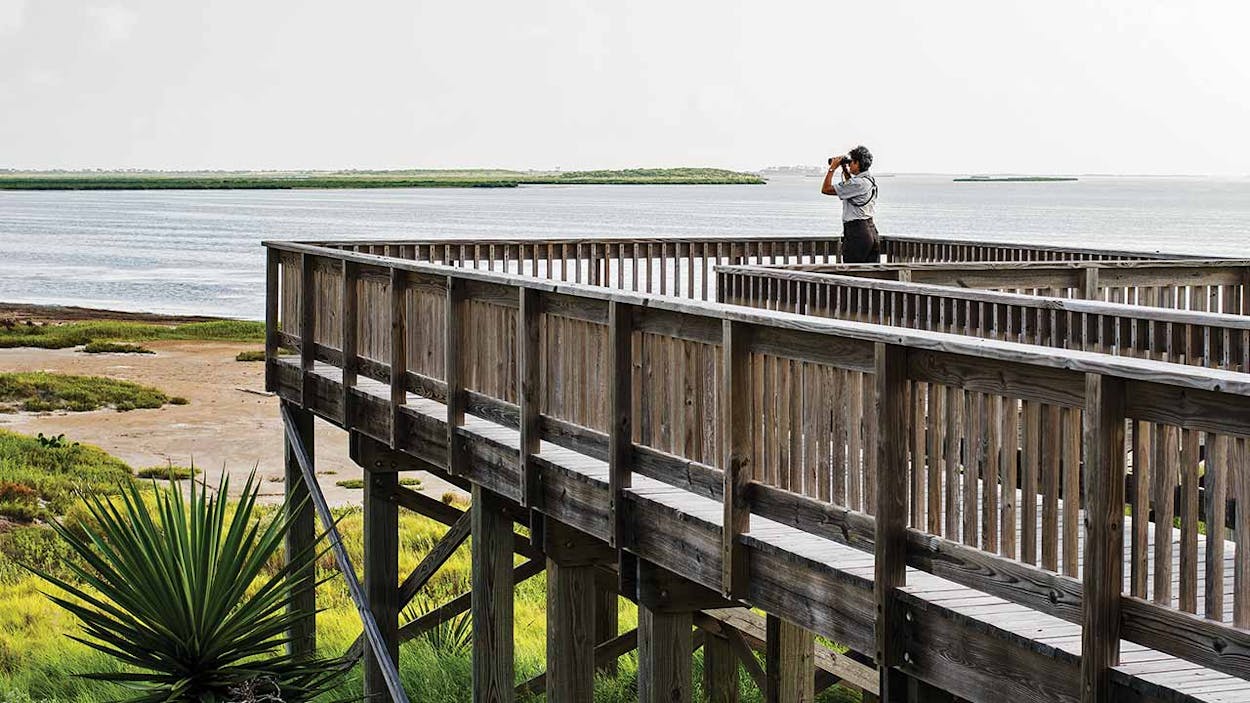On the first morning of my first birding excursion in the Rio Grande Valley, I was so close to the action that my borrowed binoculars hung forgotten around my neck. Just past the visitors center at the Laguna Atascosa National Wildlife Refuge, a small avian congress was gathering for breakfast. Plain chachalacas, long-billed thrashers, bronzed cowbirds, and three types of doves (white-winged, white-tipped, and mourning) convened around a small pond, chattering like regulars at an early-bird diner. A brilliant blue-and-black-headed green jay, one of many, flitted down to a log that had been fashioned into a trough of seeds, alighting next to a white-bellied eastern cottontail rabbit. A skinny, spotted Mexican ground squirrel scampered over to join them, and I braced for the opening bars of a Disney tune. But the only audible interlude was the cheep . . . cheep . . . cheep of my point-and-shoot, which attracted a few glances toward the wooden blind where I was standing. The chummy trio clearly considered me about as threatening as a rattlesnake in a glass tank. I was the one confined to a small enclosure, after all. They had free range of the place.
And what a place it is. I’d driven down to Los Fresnos, in Texas’s southernmost county, specifically to see Laguna Atascosa, one of the state’s last great unspoiled habitats. Encompassing nearly 100,000 coastal acres, including a number of tracts on the northern end of South Padre Island, it’s the largest remaining chunk of protected natural environment in the Valley. Edged by the shallow waters of the Laguna Madre on the east, the refuge is a diverse mix of topographies: tidal flats and sand dunes give way to coastal salt prairies dominated by cordgrass and yuccas, which segue to dense thornscrub interrupted only by “islands” of chaparral and mesquite. A full 95 percent of the Rio Grande Valley’s native brush and sabal palm forests is long gone, cleared over the decades for farming (sorghum, cotton, all those water-guzzling citrus groves) and urban development. But at Laguna Atascosa, the past prevails.

Before the refuge was established, in 1946, this land was used as a gunnery range by the U.S. Army during World War II. Before that, it was the province of—in reverse chronology—cattle ranchers, pirates, European explorers, and a diverse tapestry of Coahuiltecan peoples, whose tools and bones have since turned up in the clay lomas. But a number of its very earliest inhabitants are, of course, still here: neotropical songbirds and wintering waterfowl, deer, javelinas, gators, and cats—even though their stomping grounds and, thus, their ranks have thinned considerably.
Like most of Laguna Atascosa’s visitors, I was hoping to spot a jaguarundi or an endangered ocelot (both elusive descendants of the jaguars that once roamed these parts), but it was the birds that I’d come specifically to see. For a beginning birder like me, the Valley, one of the top birding sites in the world, is a strategic place to start. Upwards of four hundred species have been spotted at Laguna Atascosa alone, more than at any other national refuge. Still, I needed a professional site guide, so I enlisted Michael Marsden, a British expat turned South Texas birding expert, and we spent half a day meandering down the refuge’s trails, loitering by its ponds, and scanning the lush resacas, those snakelike former channels of the Rio Grande.
With each sighting, I was as gleeful as a toddler: “What’s that?” A crested caracara preening atop a Spanish dagger. “What’s that?” A Harris’s hawk sunning on a fence post. “What’s that?” A least grebe diving for dinner in Alligator Pond. By the middle of the day, our official tally ran to 37 species of birds, as well as a number of dragonflies (many so large I kept mistaking them for birds), a few zebra heliconia butterflies, two juvenile alligators (though Mama was nowhere to be seen), and one long-tailed weasel.

I was eager to add to the list the following morning. I’d signed up for one of the refuge’s kayak tours weeks earlier because I wanted to see just how salty the Laguna Madre really is (it’s one of half a dozen hypersaline lagoons in the world) and because I’d get to go for a ride down Bayside Drive, a fifteen-mile loop that cuts through the refuge’s many habitats. The road was closed to private vehicles in 2013 after two ocelots were killed by cars, and neither hiking it nor biking it (the other options) were all that appealing in the blazing summer sun. Before we made it to the water, we’d braked for roadrunners, deer, rabbits, and a handful of lumbering Texas tortoises. Limiting access to Bayside Drive may have upset some, but it underscores the pecking order here: fauna and flora first, humans second.
If Laguna Atascosa had a mascot, it would be the small, secretive ocelot, which prefers to slink through the nearly impenetrable thornscrub. Fewer than fifty of the champagne-colored cats are thought to remain in the entire country, and the only known breeding grounds are at Laguna Atascosa and a refuge just north, in Willacy County. There’s hope that the ocelots, which are closely monitored by biologists (and are most frequently spotted on specialty license plates), will follow in the (not literal) footsteps of the refuge’s American alligators, a once endangered bunch now in abundance.
My last, best chance to spot one was on the popular Twilight Tram Tour, a two-and-a-half-hour excursion back down Bayside Drive as the sun was setting and the cicadas were starting their evening thrum. Laguna Atascosa’s beauty is more subtle than the vertical magnificence of the Piney Woods or the dramatic topography of the Panhandle’s canyons, but it was unmistakable in the evening’s half-light. As lead ranger Marion Mason rattled off critters to be on the lookout for (aplomado falcons, bobcats, nilgai antelope), we all held our binoculars and cameras at the ready, like polite but curious party guests sneaking off to see what secrets we’d find behind our gracious host’s closed doors.
The Wanderer’s To-Do List
Laguna Atascosa National Wildlife Refuge, 22817 Ocelot Rd, Los Fresnos, 956-748-3607
Hike or bike the refuge’s many trails to access lookouts like Osprey Point.
Buckle up for a habitat tour through the thornscrub inhabited by ocelots.
Learn about the abundant fish and seagrasses on a kayak tour of the Laguna Madre.
Nearby, in Los Fresnos . . .
Dig into a plate of chili cheese enchiladas at Julia’s Restaurant. 220 W. Ocean Blvd, 956-233-5653
Post-birding, slip into a soaking tub at the Inn at Chachalaca Bend. 36298 Chachalaca
Bend, 956-233-1180
PLAN A WEEKEND in Los Fresnos using the Wanderer’s curated trip guide, with tips on what to do, where to eat, and where to stay around the state.
- More About:
- Birding








